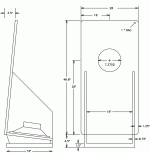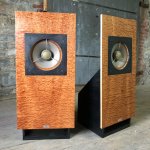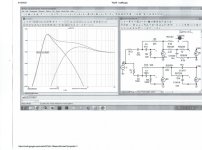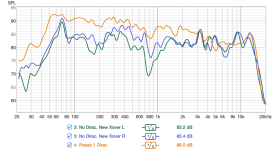I built a pair of SLOBs a while ago (and have since changed the drivers to a pair of Lii Audio Fast 8s) - and have been playing around with Dirac on my miniDSP SHD.
I was running the Pass ACN with values suitable for the SLOBs but have since recreated the curves digitally in the SHD via biquads and am using the SHD as the crossover.
When taking measurements, would there be any benefit to cover the rears of the drivers so that only the front wave is used for correction?
My thinking being that OBs do have issues with bass, but otherwise with an appropriate baffle, not really an issue. By blocking the rear wave, would my impulse measurements and corrections then be more accurate?
I was thinking a cardboard box a bit larger than each driver with some mineral wool inside loosely covering each driver - absorbing the sound from the rear but not affecting the response in the way a sealed box would, or at least not much.
This would just be for measurement, then I'd get back my regular sweet sweet OB ambiance once done measuring and take them off.
I've never seen this discussed, so figured I'd ask before spending a chunk of time on some arts and crafts.
Thanks for any wisdom-
Pete
I was running the Pass ACN with values suitable for the SLOBs but have since recreated the curves digitally in the SHD via biquads and am using the SHD as the crossover.
When taking measurements, would there be any benefit to cover the rears of the drivers so that only the front wave is used for correction?
My thinking being that OBs do have issues with bass, but otherwise with an appropriate baffle, not really an issue. By blocking the rear wave, would my impulse measurements and corrections then be more accurate?
I was thinking a cardboard box a bit larger than each driver with some mineral wool inside loosely covering each driver - absorbing the sound from the rear but not affecting the response in the way a sealed box would, or at least not much.
This would just be for measurement, then I'd get back my regular sweet sweet OB ambiance once done measuring and take them off.
I've never seen this discussed, so figured I'd ask before spending a chunk of time on some arts and crafts.
Thanks for any wisdom-
Pete
I would measure the fullrange in the nearfield of 20 to 30 cm on axis. So the backwave plays no role.
Farfield measurements cannot work or there must be multiple averaged ones what is difficult to do.
One advantage of fullrange drivers is you can measure them much better in the nearfield than multiways.
You must correct the speaker, not the room.
Important is 200hz to 5khz to be really linear.
Highs and lows usually are manipulated to taste.
The most important for colour of sound, impulse response, phase perception is the said area.
Farfield measurements cannot work or there must be multiple averaged ones what is difficult to do.
One advantage of fullrange drivers is you can measure them much better in the nearfield than multiways.
You must correct the speaker, not the room.
Important is 200hz to 5khz to be really linear.
Highs and lows usually are manipulated to taste.
The most important for colour of sound, impulse response, phase perception is the said area.
Last edited:
I'm not the only one who has tried using absorption to create anechoic conditions. It is not easy, in fact it can be very difficult at lower/middle frequencies. I would try to consider other options first. Outside might work.
you do not need to cover the back side.
You can check measurement and dsp also at 10 to 20cm distance.
I got good results at 20 to 30cm distance also taking care of box dimension.
Listen to the corrected curves and adjust.
Best is record own instruments and then play them at the same time like your speakers reproducing your own in the nearfield recorded instruments.
Then you can fine tune the linearization.
You can check measurement and dsp also at 10 to 20cm distance.
I got good results at 20 to 30cm distance also taking care of box dimension.
Listen to the corrected curves and adjust.
Best is record own instruments and then play them at the same time like your speakers reproducing your own in the nearfield recorded instruments.
Then you can fine tune the linearization.
fullranges:
if the f response is linear the phase will be linear, too.
This is a privilege of fullrange drivers.
if the f response is linear the phase will be linear, too.
This is a privilege of fullrange drivers.
Thanks for the responses @Freedom666 and @AllenB - what I'm struggling with in this case is the miniDSP SHD has Dirac built in, but I can't use my own FIR filters on the SHD, just IIR via PEQ and the automated Dirac routine - so I can't use Rephase or anything like that.
I'm pretty good w/ REW as far as measurements (and from REW in this case I know the the current in-room response isn't too egregious), but am especially interested in correction in the time domain. To run Dirac, they need to be in-room and measurements taken around the MLP.
So that was my thinking to "clean it up" a bit re the backwave for measurement purposes with some sort of absorption if that may make it "easier" for Dirac - and if that'd be worth the time. (And thinking that an absorptive box around the driver would be easy - much easier than, say, trying this idea with Maggies or Martin Logans.)
Round trip to the rear wall is about 7' (2M), which takes about 6ms, which I would think would be an obvious reflection, but not sure how Dirac deals with that.
Grand Plan someday is to use Acourate and a different processor with my own filters, but until then, trying to get the most out of Dirac.
Realizing this may be more of a niche Dirac question than a general speaker question...
I'm pretty good w/ REW as far as measurements (and from REW in this case I know the the current in-room response isn't too egregious), but am especially interested in correction in the time domain. To run Dirac, they need to be in-room and measurements taken around the MLP.
So that was my thinking to "clean it up" a bit re the backwave for measurement purposes with some sort of absorption if that may make it "easier" for Dirac - and if that'd be worth the time. (And thinking that an absorptive box around the driver would be easy - much easier than, say, trying this idea with Maggies or Martin Logans.)
Round trip to the rear wall is about 7' (2M), which takes about 6ms, which I would think would be an obvious reflection, but not sure how Dirac deals with that.
Grand Plan someday is to use Acourate and a different processor with my own filters, but until then, trying to get the most out of Dirac.
Realizing this may be more of a niche Dirac question than a general speaker question...
...and @Freedom666 to your point re the FR driver, it's linear, but needs some help - these are the Fast 8s from lii-song.com which I later learned are not the "real" ones - you can only get those from aliexpress - not terrible, but some odd peaks in the upper mids I'd like to try and fix.
I guess the whole point of this exercise is to get the most I can out of a less-than-ideal setup.
I guess the whole point of this exercise is to get the most I can out of a less-than-ideal setup.
Measurement in nearfield is ok above roughly 500Hz. But baffle diffraction effects and off-axis responses must be taken care of too.
What is the size of your baffle and what is driver's position on it? With this info a simulation software can give info for eq below 500Hz.
Another possibility below 500Hz is to do several measurements near listening spot, use long gating and 1/2 octave smoothing then use averaged curve to set eq. And remeasure and listen!
What is the size of your baffle and what is driver's position on it? With this info a simulation software can give info for eq below 500Hz.
Another possibility below 500Hz is to do several measurements near listening spot, use long gating and 1/2 octave smoothing then use averaged curve to set eq. And remeasure and listen!
Last edited:
I do not think so as there will still be ob loudspeaker in room with full radiationWhen taking measurements, would there be any benefit to cover the rears of the drivers so that only the front wave is used for correction?
@peraho
if you use dsp you can do some cone treatment against resonances. So a loss in the highs can be compensated.
I am a fan of the alu foil tweak for fullranges. First try with noname fullrange before you try on the beloved ones.
if you use dsp you can do some cone treatment against resonances. So a loss in the highs can be compensated.
I am a fan of the alu foil tweak for fullranges. First try with noname fullrange before you try on the beloved ones.
Hello,
here I want to describe how I do make a sandwich cone with aluminium foil.
This can be done with normal household aluminium foil and normal glue you can buy everywhere as "universal glue".
You need a scissor and the materials like aluminium foil, glue and the loudspeaker.
The foil can be applied easily to paper cones / diaphragms.
You can use thin aluminium foil from the gold smith and the glue they sell (in german "Anlegemilch") for making sandwich cones with polypropylene loudspeaker cones as here normal glue will not work. Also for delicate whizzer cones the thin aluminium...
here I want to describe how I do make a sandwich cone with aluminium foil.
This can be done with normal household aluminium foil and normal glue you can buy everywhere as "universal glue".
You need a scissor and the materials like aluminium foil, glue and the loudspeaker.
The foil can be applied easily to paper cones / diaphragms.
You can use thin aluminium foil from the gold smith and the glue they sell (in german "Anlegemilch") for making sandwich cones with polypropylene loudspeaker cones as here normal glue will not work. Also for delicate whizzer cones the thin aluminium...
@Juhazi - these are a pair of the Nelson Pass SLOBs, now with "Lii Audio" Fast-8s and Eminence 4015LFs and using a miniDSP SHD as the crossover - overall delighted with the setup, I'm just trying to ensure I'm getting the most out of Dirac built into the SHD, but do need to take better nearfield measurements - thanks for the tips.
@Freedom666 - I hadn't seen that thread, I'm intrigued - will dig into that, thanks...
@danibosn - yeah, right right, I hear you - I haven't measured with any absorption on the rears, I suppose the only way is to try it, and likely not much a help, but I am curious.
@Freedom666 - I hadn't seen that thread, I'm intrigued - will dig into that, thanks...
@danibosn - yeah, right right, I hear you - I haven't measured with any absorption on the rears, I suppose the only way is to try it, and likely not much a help, but I am curious.
Attachments
My goal would be to not use Dirac, since Dirac cannot fix acoustic problems.the automated Dirac routine
This means that if you decide to use it you should first do as much work with your acoustic problems as you are willing to do.
SLOB baffle with 8" ideal driver - diffraction on-axis at 3meters

The effect of mic distance

Dirac Live can eq for whole range, it uses farfield summed data and includes timing (=distance to speaker) I have not used it but per reviews it tries to lift spl of dips in response, which is not always wise. https://archimago.blogspot.com/search?q=dirac
The effect of mic distance
Dirac Live can eq for whole range, it uses farfield summed data and includes timing (=distance to speaker) I have not used it but per reviews it tries to lift spl of dips in response, which is not always wise. https://archimago.blogspot.com/search?q=dirac
Last edited:
@Juhazi - thanks so much for that sim, really appreciate it. That explains the dip I was seeing around 800Hz, which I was initially surprised me, but makes perfect sense, and know I'd see a similar sim before when building these. We forget in order to remember...
@AllenB - overall my room is about as well treated as dweller of a small NYC rental apartment can treat - I built corner traps for each corner, as well as a (easily removable!) 17" x 17" acoustic soffit w/ 6" of mineral wool on the bottom and front surface with a void behind, so bass pretty decent.
The room is about 10'x 17' with 9.5' ceilings, and about half (~10' x 10') is for listening - it is a small apartment after all. These SLOBs are certainly too big for the room, I know, I know - but I just fell in love with that open baffle bass. Next projects are some ripole subs and maybe some sort of narrower OB setup eventually, and that's the fun of all this... (Currently they're about 4' from the rear wall, about 1.5' (I know...) from the side walls... I'm about 5' away, so essentially nearfield?)
I just love the OB sound though - kind of like giant 3D headphones in my setup and the presence and intimacy of person-with-acoustic-guitar lights me up every time, as well as anything with an upright bass, but to each their own. Plus I think the OB bass is less likely to annoy my neighbors which is key too.
After all this help, I think my next steps may be to remeasure nearfield and from the MLP and add some careful PEQ of my own rather than Dirac, and see how that goes.
I may also try redoing the crossover as well based on the measurements. My original thought was to start with the "established" SLOB curves (attached below), but based on my measured response, I may be able to improve on that.
I feel like it sounds better than it looks? Or we just tend to all fall in love with our own creations?
Thanks again for all the help!
@AllenB - overall my room is about as well treated as dweller of a small NYC rental apartment can treat - I built corner traps for each corner, as well as a (easily removable!) 17" x 17" acoustic soffit w/ 6" of mineral wool on the bottom and front surface with a void behind, so bass pretty decent.
The room is about 10'x 17' with 9.5' ceilings, and about half (~10' x 10') is for listening - it is a small apartment after all. These SLOBs are certainly too big for the room, I know, I know - but I just fell in love with that open baffle bass. Next projects are some ripole subs and maybe some sort of narrower OB setup eventually, and that's the fun of all this... (Currently they're about 4' from the rear wall, about 1.5' (I know...) from the side walls... I'm about 5' away, so essentially nearfield?)
I just love the OB sound though - kind of like giant 3D headphones in my setup and the presence and intimacy of person-with-acoustic-guitar lights me up every time, as well as anything with an upright bass, but to each their own. Plus I think the OB bass is less likely to annoy my neighbors which is key too.
After all this help, I think my next steps may be to remeasure nearfield and from the MLP and add some careful PEQ of my own rather than Dirac, and see how that goes.
I may also try redoing the crossover as well based on the measurements. My original thought was to start with the "established" SLOB curves (attached below), but based on my measured response, I may be able to improve on that.
I feel like it sounds better than it looks? Or we just tend to all fall in love with our own creations?
Thanks again for all the help!
Attachments
Maybe 😉
It seems you like a sense of envelopment from many reflections. I think that the spatial diversity and the timing of these is part of the experience. So if you're going to spread these out, how do you take control of the situation?
An open baffle varies quite a bit with frequency. There are builders who focus on dipole radiation. A dipole is like an open baffle that has order and planning. It is consistent with frequency.
I'm not saying you have to consider this but it may give you ideas when you are seeing problems you want to fix.
It seems you like a sense of envelopment from many reflections. I think that the spatial diversity and the timing of these is part of the experience. So if you're going to spread these out, how do you take control of the situation?
An open baffle varies quite a bit with frequency. There are builders who focus on dipole radiation. A dipole is like an open baffle that has order and planning. It is consistent with frequency.
I'm not saying you have to consider this but it may give you ideas when you are seeing problems you want to fix.
Every open baffle is dipole (not with back closed drivers, of course) and radiate as dipole in whole spectrum. What we are most interested for, is freq range below first dipole peak as in that range radiation is CD . Unfortunately, those ranges are quite short in practice as we are limited with drivers size and displacement, so if want to have, as much as possible, CD radiation an OB should be at least 3 (4 is better) ways and every driver should have different sized baffle or no baffle at allAn open baffle varies quite a bit with frequency. There are builders who focus on dipole radiation. A dipole is like an open baffle that has order and planning. It is consistent with frequency.
I do not know how high the SLOB can play but you can lower the dip in freq range with bigger baffle, and try to use full range above first dipole dip (now on 800 Hz). The response will be wavy but amplitudes are much smaller than first peak as can be seen on Juhazi simulation.That explains the dip I was seeing around 800Hz
As well, the peak/dip are so pronounced because the driver is mounted almost simmetrically to three edges. Little bit of offset can mitigate dipole peak/dip significantly. It is easy to simulate in Edge.
- Home
- Loudspeakers
- Multi-Way
- OB impulse response measurements - helped by absorbing the rear wave?



